Woolworths' Adherence to Australian Accounting Standards (AAS)
VerifiedAdded on 2023/06/12
|25
|6487
|256
Report
AI Summary
This research report delves into the accounting standards followed by Woolworths, an Australian company, focusing on compliance with the Australian Accounting Standards (AAS) as governed by the Australian Accounting Standards Board (AASB). The study examines Woolworths' financial statements, prepared in accordance with AAS, and evaluates the awareness of accountants and auditors regarding recent amendments to these standards. It further analyzes the harmonization of domestic and international accounting standards within the company, and explores the role of Woolworths' Audit, Risk, Management & Compliance Committee in reforming corporate reporting frameworks. The report uses descriptive research to highlight the increased transparency in financial reporting achieved through the implementation of global accounting standards within Woolworths.
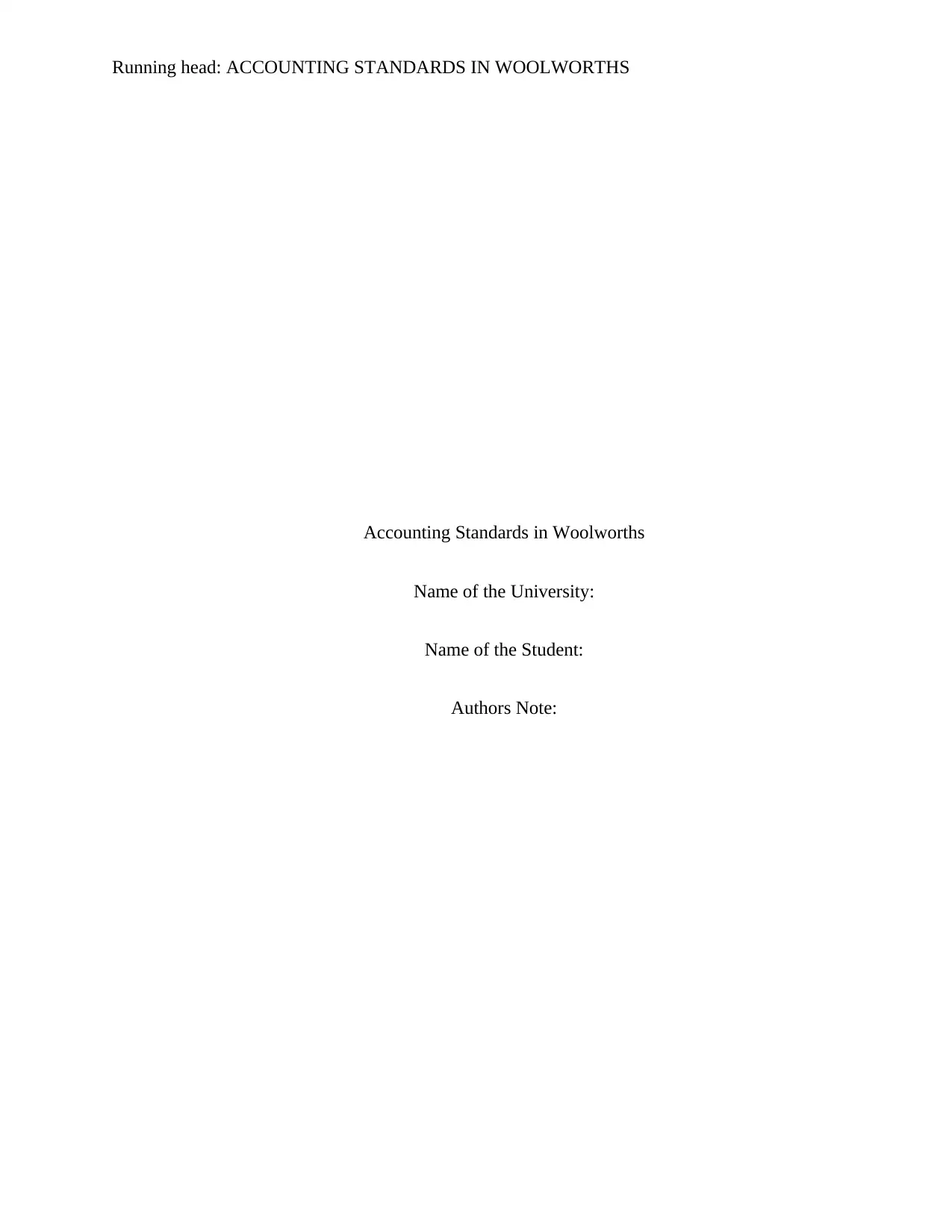
Running head: ACCOUNTING STANDARDS IN WOOLWORTHS
Accounting Standards in Woolworths
Name of the University:
Name of the Student:
Authors Note:
Accounting Standards in Woolworths
Name of the University:
Name of the Student:
Authors Note:
Paraphrase This Document
Need a fresh take? Get an instant paraphrase of this document with our AI Paraphraser
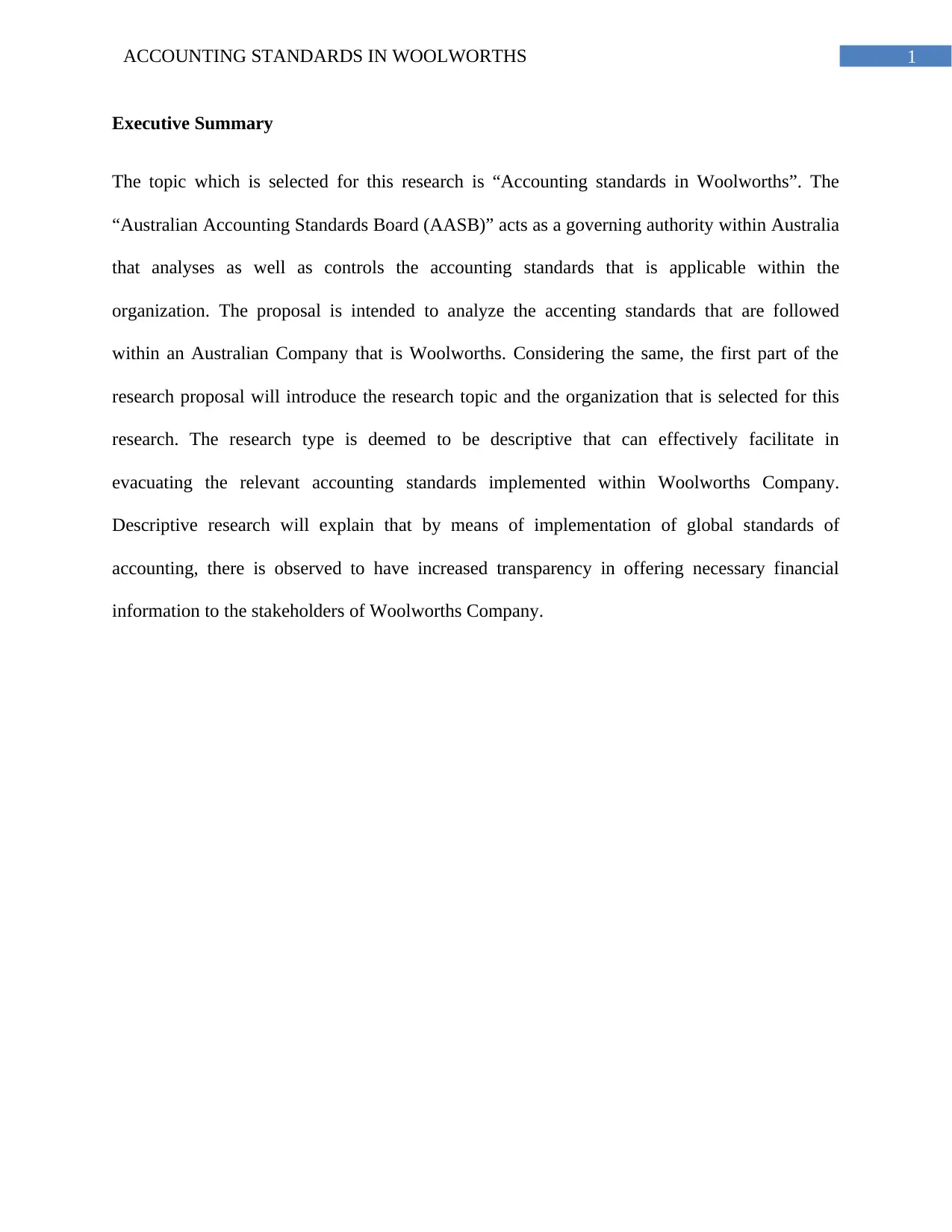
1ACCOUNTING STANDARDS IN WOOLWORTHS
Executive Summary
The topic which is selected for this research is “Accounting standards in Woolworths”. The
“Australian Accounting Standards Board (AASB)” acts as a governing authority within Australia
that analyses as well as controls the accounting standards that is applicable within the
organization. The proposal is intended to analyze the accenting standards that are followed
within an Australian Company that is Woolworths. Considering the same, the first part of the
research proposal will introduce the research topic and the organization that is selected for this
research. The research type is deemed to be descriptive that can effectively facilitate in
evacuating the relevant accounting standards implemented within Woolworths Company.
Descriptive research will explain that by means of implementation of global standards of
accounting, there is observed to have increased transparency in offering necessary financial
information to the stakeholders of Woolworths Company.
Executive Summary
The topic which is selected for this research is “Accounting standards in Woolworths”. The
“Australian Accounting Standards Board (AASB)” acts as a governing authority within Australia
that analyses as well as controls the accounting standards that is applicable within the
organization. The proposal is intended to analyze the accenting standards that are followed
within an Australian Company that is Woolworths. Considering the same, the first part of the
research proposal will introduce the research topic and the organization that is selected for this
research. The research type is deemed to be descriptive that can effectively facilitate in
evacuating the relevant accounting standards implemented within Woolworths Company.
Descriptive research will explain that by means of implementation of global standards of
accounting, there is observed to have increased transparency in offering necessary financial
information to the stakeholders of Woolworths Company.

2ACCOUNTING STANDARDS IN WOOLWORTHS
Table of Contents
1. Introduction to the Research........................................................................................4
1.1. Topic Introduction....................................................................................................4
1.2. Overview of the Company........................................................................................4
1.3. Structure of Proposal................................................................................................5
2. Research Problem and Objectives...............................................................................5
3. Literature Review..........................................................................................................6
3.1. Financial statements of Woolworths doneas per with the Australian Accounting
Standards......................................................................................................................................7
3.2. Accountants and Auditors are aware regarding the recent amendments in the
Australian Accounting Standards................................................................................................8
3.3. Harmonization between the AAS (Australian Accounting Standards) and the IAS
(International Accounting Standards)........................................................................................10
3.4. Management of a company has formulated Audit, Risk, Management &
Compliance Committee for the reformation of the corporate reporting framework.................12
4. Research Design and Methodology...............................................................................13
4.1. Justification of Research Type................................................................................13
4.2. Justification of Research Approach........................................................................14
4.3. Type of Data that will be used................................................................................14
4.4. Data Collection.......................................................................................................15
Table of Contents
1. Introduction to the Research........................................................................................4
1.1. Topic Introduction....................................................................................................4
1.2. Overview of the Company........................................................................................4
1.3. Structure of Proposal................................................................................................5
2. Research Problem and Objectives...............................................................................5
3. Literature Review..........................................................................................................6
3.1. Financial statements of Woolworths doneas per with the Australian Accounting
Standards......................................................................................................................................7
3.2. Accountants and Auditors are aware regarding the recent amendments in the
Australian Accounting Standards................................................................................................8
3.3. Harmonization between the AAS (Australian Accounting Standards) and the IAS
(International Accounting Standards)........................................................................................10
3.4. Management of a company has formulated Audit, Risk, Management &
Compliance Committee for the reformation of the corporate reporting framework.................12
4. Research Design and Methodology...............................................................................13
4.1. Justification of Research Type................................................................................13
4.2. Justification of Research Approach........................................................................14
4.3. Type of Data that will be used................................................................................14
4.4. Data Collection.......................................................................................................15
⊘ This is a preview!⊘
Do you want full access?
Subscribe today to unlock all pages.

Trusted by 1+ million students worldwide
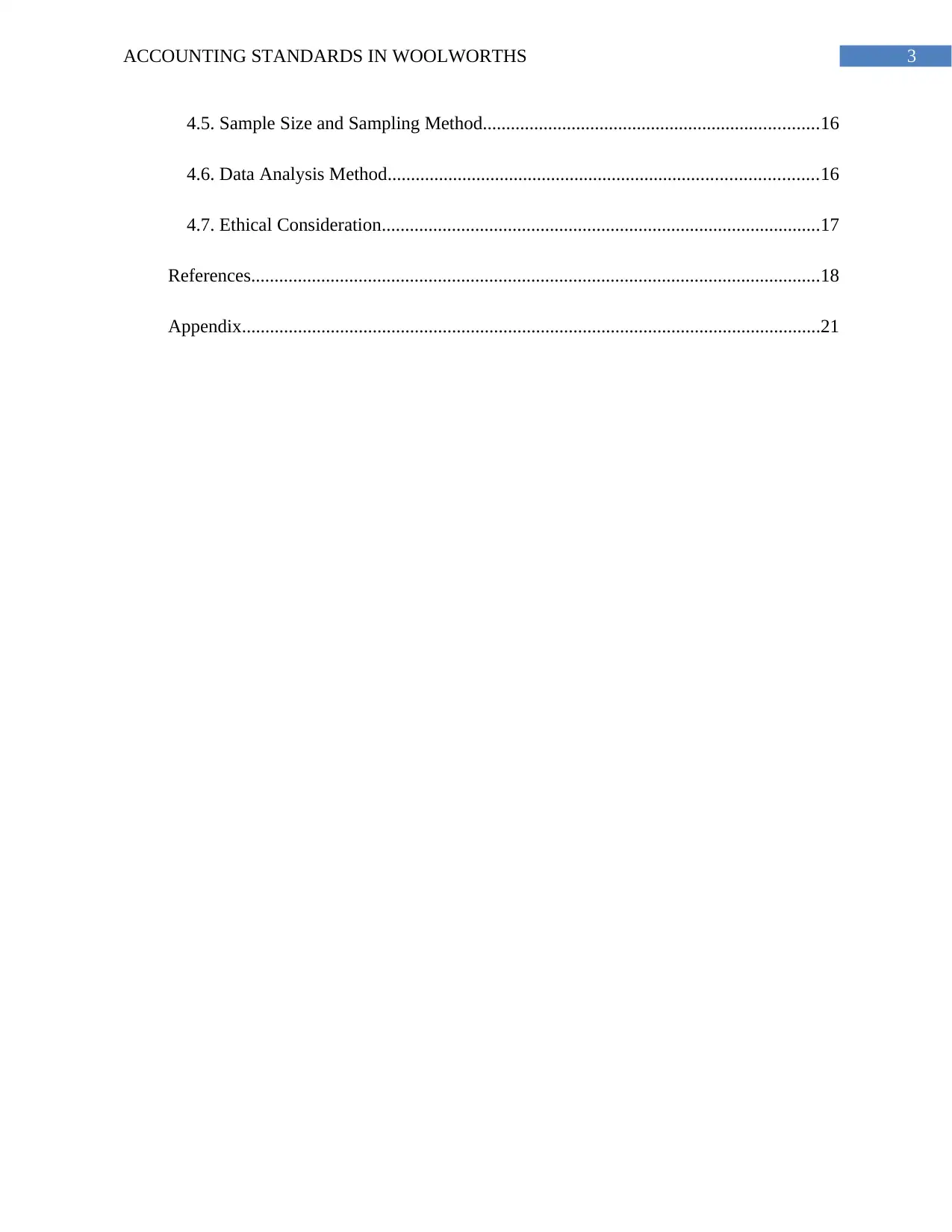
3ACCOUNTING STANDARDS IN WOOLWORTHS
4.5. Sample Size and Sampling Method........................................................................16
4.6. Data Analysis Method............................................................................................16
4.7. Ethical Consideration..............................................................................................17
References..........................................................................................................................18
Appendix............................................................................................................................21
4.5. Sample Size and Sampling Method........................................................................16
4.6. Data Analysis Method............................................................................................16
4.7. Ethical Consideration..............................................................................................17
References..........................................................................................................................18
Appendix............................................................................................................................21
Paraphrase This Document
Need a fresh take? Get an instant paraphrase of this document with our AI Paraphraser
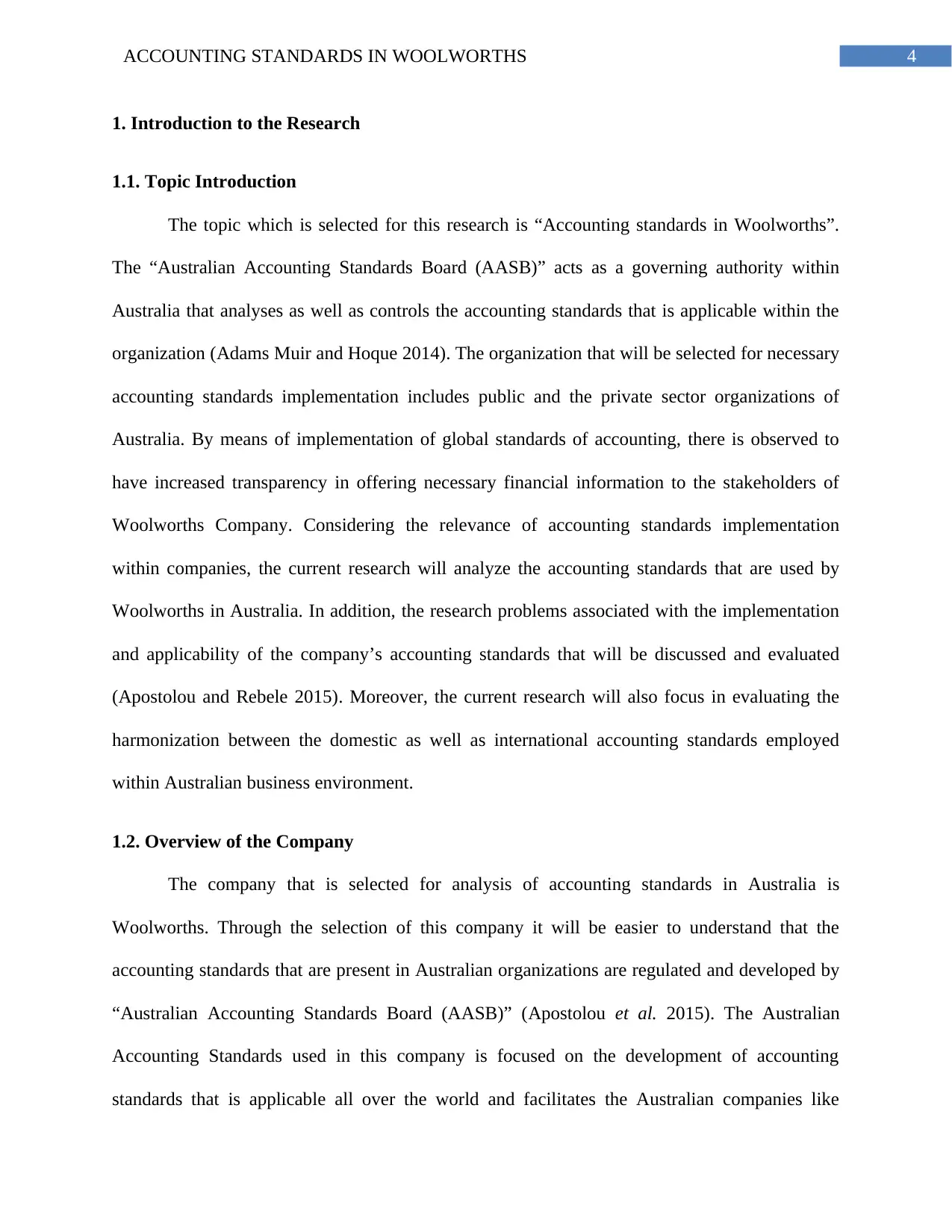
4ACCOUNTING STANDARDS IN WOOLWORTHS
1. Introduction to the Research
1.1. Topic Introduction
The topic which is selected for this research is “Accounting standards in Woolworths”.
The “Australian Accounting Standards Board (AASB)” acts as a governing authority within
Australia that analyses as well as controls the accounting standards that is applicable within the
organization (Adams Muir and Hoque 2014). The organization that will be selected for necessary
accounting standards implementation includes public and the private sector organizations of
Australia. By means of implementation of global standards of accounting, there is observed to
have increased transparency in offering necessary financial information to the stakeholders of
Woolworths Company. Considering the relevance of accounting standards implementation
within companies, the current research will analyze the accounting standards that are used by
Woolworths in Australia. In addition, the research problems associated with the implementation
and applicability of the company’s accounting standards that will be discussed and evaluated
(Apostolou and Rebele 2015). Moreover, the current research will also focus in evaluating the
harmonization between the domestic as well as international accounting standards employed
within Australian business environment.
1.2. Overview of the Company
The company that is selected for analysis of accounting standards in Australia is
Woolworths. Through the selection of this company it will be easier to understand that the
accounting standards that are present in Australian organizations are regulated and developed by
“Australian Accounting Standards Board (AASB)” (Apostolou et al. 2015). The Australian
Accounting Standards used in this company is focused on the development of accounting
standards that is applicable all over the world and facilitates the Australian companies like
1. Introduction to the Research
1.1. Topic Introduction
The topic which is selected for this research is “Accounting standards in Woolworths”.
The “Australian Accounting Standards Board (AASB)” acts as a governing authority within
Australia that analyses as well as controls the accounting standards that is applicable within the
organization (Adams Muir and Hoque 2014). The organization that will be selected for necessary
accounting standards implementation includes public and the private sector organizations of
Australia. By means of implementation of global standards of accounting, there is observed to
have increased transparency in offering necessary financial information to the stakeholders of
Woolworths Company. Considering the relevance of accounting standards implementation
within companies, the current research will analyze the accounting standards that are used by
Woolworths in Australia. In addition, the research problems associated with the implementation
and applicability of the company’s accounting standards that will be discussed and evaluated
(Apostolou and Rebele 2015). Moreover, the current research will also focus in evaluating the
harmonization between the domestic as well as international accounting standards employed
within Australian business environment.
1.2. Overview of the Company
The company that is selected for analysis of accounting standards in Australia is
Woolworths. Through the selection of this company it will be easier to understand that the
accounting standards that are present in Australian organizations are regulated and developed by
“Australian Accounting Standards Board (AASB)” (Apostolou et al. 2015). The Australian
Accounting Standards used in this company is focused on the development of accounting
standards that is applicable all over the world and facilitates the Australian companies like
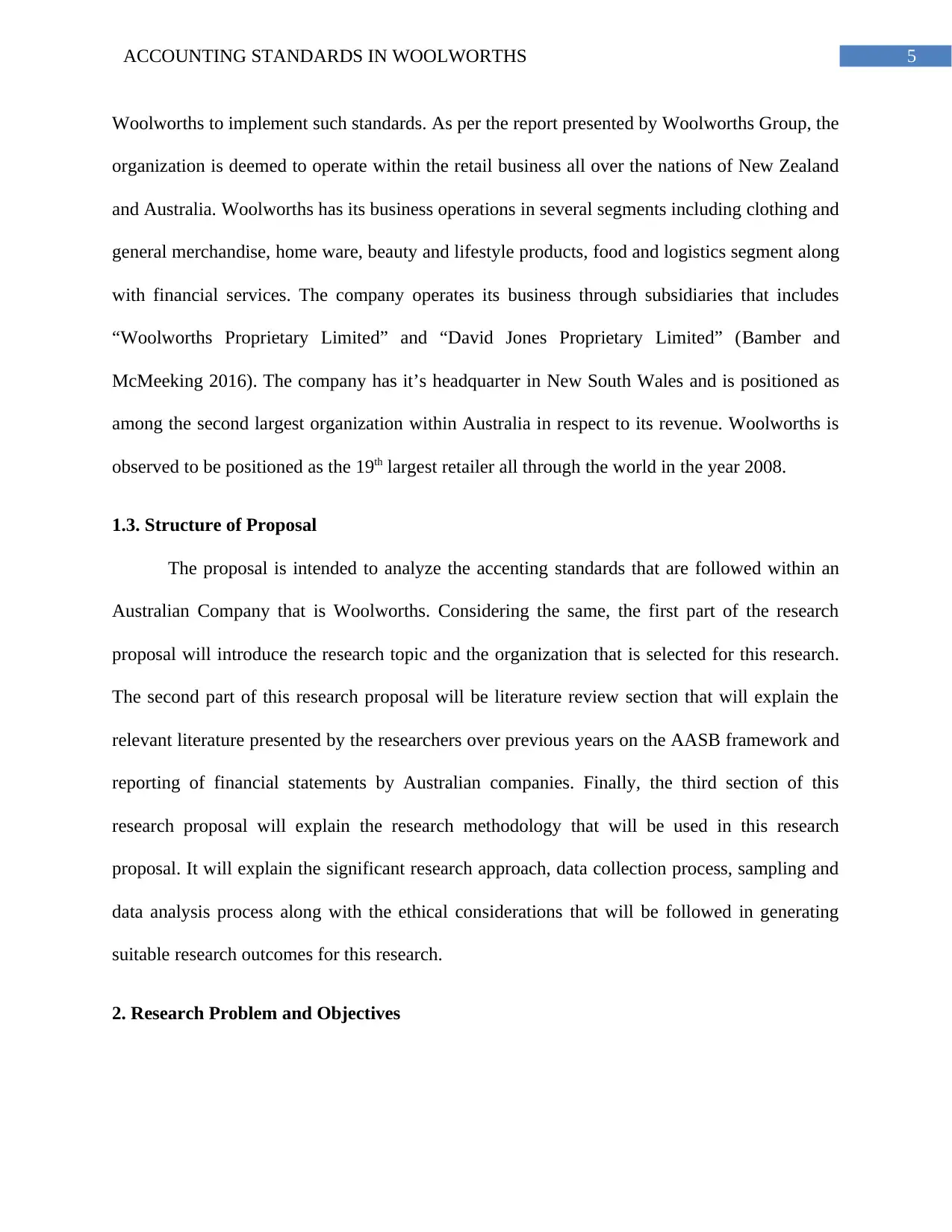
5ACCOUNTING STANDARDS IN WOOLWORTHS
Woolworths to implement such standards. As per the report presented by Woolworths Group, the
organization is deemed to operate within the retail business all over the nations of New Zealand
and Australia. Woolworths has its business operations in several segments including clothing and
general merchandise, home ware, beauty and lifestyle products, food and logistics segment along
with financial services. The company operates its business through subsidiaries that includes
“Woolworths Proprietary Limited” and “David Jones Proprietary Limited” (Bamber and
McMeeking 2016). The company has it’s headquarter in New South Wales and is positioned as
among the second largest organization within Australia in respect to its revenue. Woolworths is
observed to be positioned as the 19th largest retailer all through the world in the year 2008.
1.3. Structure of Proposal
The proposal is intended to analyze the accenting standards that are followed within an
Australian Company that is Woolworths. Considering the same, the first part of the research
proposal will introduce the research topic and the organization that is selected for this research.
The second part of this research proposal will be literature review section that will explain the
relevant literature presented by the researchers over previous years on the AASB framework and
reporting of financial statements by Australian companies. Finally, the third section of this
research proposal will explain the research methodology that will be used in this research
proposal. It will explain the significant research approach, data collection process, sampling and
data analysis process along with the ethical considerations that will be followed in generating
suitable research outcomes for this research.
2. Research Problem and Objectives
Woolworths to implement such standards. As per the report presented by Woolworths Group, the
organization is deemed to operate within the retail business all over the nations of New Zealand
and Australia. Woolworths has its business operations in several segments including clothing and
general merchandise, home ware, beauty and lifestyle products, food and logistics segment along
with financial services. The company operates its business through subsidiaries that includes
“Woolworths Proprietary Limited” and “David Jones Proprietary Limited” (Bamber and
McMeeking 2016). The company has it’s headquarter in New South Wales and is positioned as
among the second largest organization within Australia in respect to its revenue. Woolworths is
observed to be positioned as the 19th largest retailer all through the world in the year 2008.
1.3. Structure of Proposal
The proposal is intended to analyze the accenting standards that are followed within an
Australian Company that is Woolworths. Considering the same, the first part of the research
proposal will introduce the research topic and the organization that is selected for this research.
The second part of this research proposal will be literature review section that will explain the
relevant literature presented by the researchers over previous years on the AASB framework and
reporting of financial statements by Australian companies. Finally, the third section of this
research proposal will explain the research methodology that will be used in this research
proposal. It will explain the significant research approach, data collection process, sampling and
data analysis process along with the ethical considerations that will be followed in generating
suitable research outcomes for this research.
2. Research Problem and Objectives
⊘ This is a preview!⊘
Do you want full access?
Subscribe today to unlock all pages.

Trusted by 1+ million students worldwide

6ACCOUNTING STANDARDS IN WOOLWORTHS
The major research problem that is highlighted in this research is focused on evaluating
the financial statements of Woolworths that has been prepared as per Australian Accounting
Standards. To analyses the compliance of necessary standards in Woolworths, the audit, risk,
management and compliance committee has been developed in order to monitor the
implementation of accounting principles along with documenting its financial statements (Berger
2018). Another concern that is to be highlighted in this research is focused on analyzing whether
the auditors of the organization are aware of the recent amendments made in Australian
Accounting Standards. Moreover, focus is also kept in analyzing the harmonization of domestic
and international accounting standards and its efficient use within the Australian organizations.
Considering such research problem, the research objectives those are to be met through
completion of this research are explained under:
To analyze the financial statements of Woolworths prepared as per Australian
Accounting Standards (AAS)
To evaluate in which ways the accountants and the auditors are aware of the current
amendments within Australian Accounting Standards
To evaluate the harmonization of domestic and international accounting standards
To analyze the ways in which company’s management has developed Audit, risk,
management and compliance committees in order to reform the framework of corporate
accounting
3. Literature Review
The major research problem that is highlighted in this research is focused on evaluating
the financial statements of Woolworths that has been prepared as per Australian Accounting
Standards. To analyses the compliance of necessary standards in Woolworths, the audit, risk,
management and compliance committee has been developed in order to monitor the
implementation of accounting principles along with documenting its financial statements (Berger
2018). Another concern that is to be highlighted in this research is focused on analyzing whether
the auditors of the organization are aware of the recent amendments made in Australian
Accounting Standards. Moreover, focus is also kept in analyzing the harmonization of domestic
and international accounting standards and its efficient use within the Australian organizations.
Considering such research problem, the research objectives those are to be met through
completion of this research are explained under:
To analyze the financial statements of Woolworths prepared as per Australian
Accounting Standards (AAS)
To evaluate in which ways the accountants and the auditors are aware of the current
amendments within Australian Accounting Standards
To evaluate the harmonization of domestic and international accounting standards
To analyze the ways in which company’s management has developed Audit, risk,
management and compliance committees in order to reform the framework of corporate
accounting
3. Literature Review
Paraphrase This Document
Need a fresh take? Get an instant paraphrase of this document with our AI Paraphraser
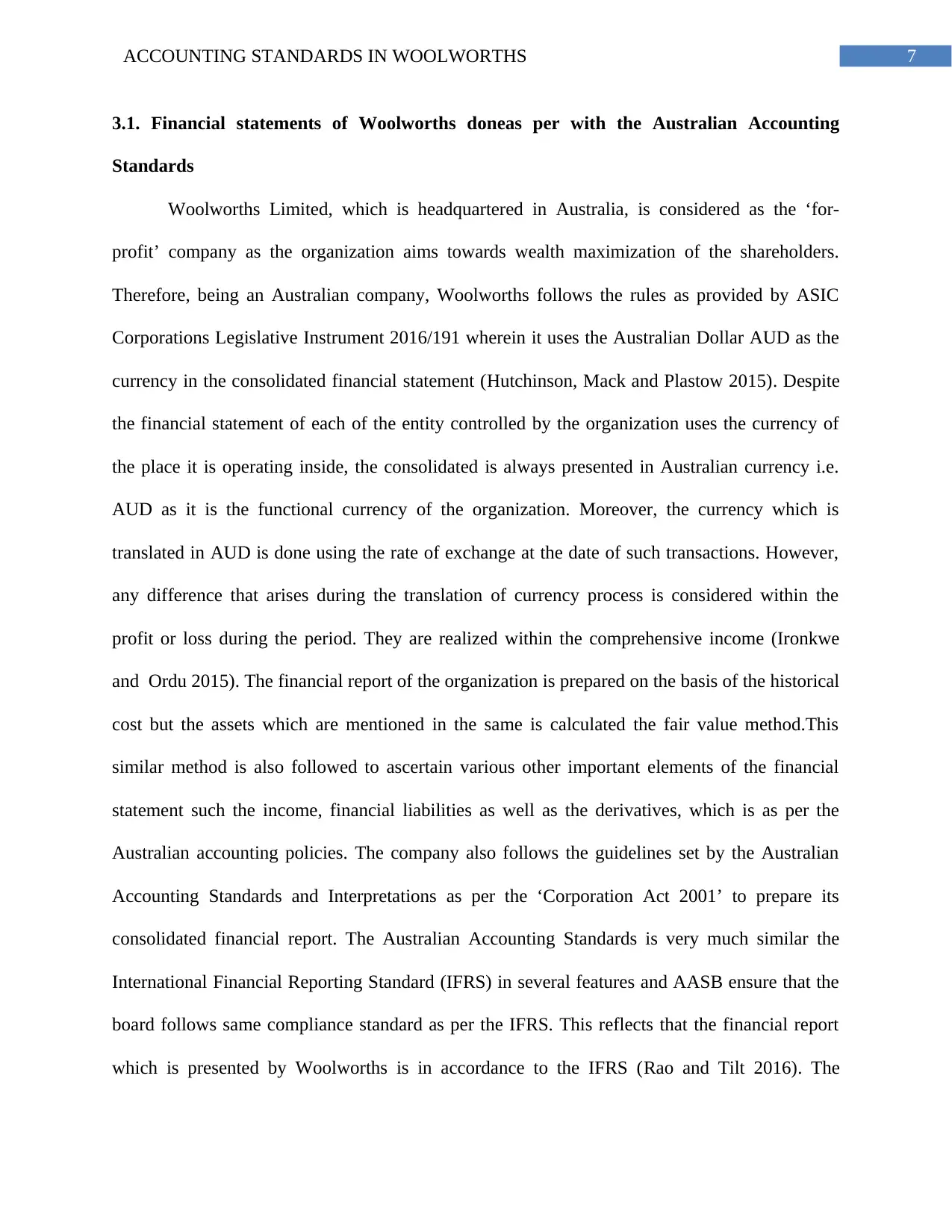
7ACCOUNTING STANDARDS IN WOOLWORTHS
3.1. Financial statements of Woolworths doneas per with the Australian Accounting
Standards
Woolworths Limited, which is headquartered in Australia, is considered as the ‘for-
profit’ company as the organization aims towards wealth maximization of the shareholders.
Therefore, being an Australian company, Woolworths follows the rules as provided by ASIC
Corporations Legislative Instrument 2016/191 wherein it uses the Australian Dollar AUD as the
currency in the consolidated financial statement (Hutchinson, Mack and Plastow 2015). Despite
the financial statement of each of the entity controlled by the organization uses the currency of
the place it is operating inside, the consolidated is always presented in Australian currency i.e.
AUD as it is the functional currency of the organization. Moreover, the currency which is
translated in AUD is done using the rate of exchange at the date of such transactions. However,
any difference that arises during the translation of currency process is considered within the
profit or loss during the period. They are realized within the comprehensive income (Ironkwe
and Ordu 2015). The financial report of the organization is prepared on the basis of the historical
cost but the assets which are mentioned in the same is calculated the fair value method.This
similar method is also followed to ascertain various other important elements of the financial
statement such the income, financial liabilities as well as the derivatives, which is as per the
Australian accounting policies. The company also follows the guidelines set by the Australian
Accounting Standards and Interpretations as per the ‘Corporation Act 2001’ to prepare its
consolidated financial report. The Australian Accounting Standards is very much similar the
International Financial Reporting Standard (IFRS) in several features and AASB ensure that the
board follows same compliance standard as per the IFRS. This reflects that the financial report
which is presented by Woolworths is in accordance to the IFRS (Rao and Tilt 2016). The
3.1. Financial statements of Woolworths doneas per with the Australian Accounting
Standards
Woolworths Limited, which is headquartered in Australia, is considered as the ‘for-
profit’ company as the organization aims towards wealth maximization of the shareholders.
Therefore, being an Australian company, Woolworths follows the rules as provided by ASIC
Corporations Legislative Instrument 2016/191 wherein it uses the Australian Dollar AUD as the
currency in the consolidated financial statement (Hutchinson, Mack and Plastow 2015). Despite
the financial statement of each of the entity controlled by the organization uses the currency of
the place it is operating inside, the consolidated is always presented in Australian currency i.e.
AUD as it is the functional currency of the organization. Moreover, the currency which is
translated in AUD is done using the rate of exchange at the date of such transactions. However,
any difference that arises during the translation of currency process is considered within the
profit or loss during the period. They are realized within the comprehensive income (Ironkwe
and Ordu 2015). The financial report of the organization is prepared on the basis of the historical
cost but the assets which are mentioned in the same is calculated the fair value method.This
similar method is also followed to ascertain various other important elements of the financial
statement such the income, financial liabilities as well as the derivatives, which is as per the
Australian accounting policies. The company also follows the guidelines set by the Australian
Accounting Standards and Interpretations as per the ‘Corporation Act 2001’ to prepare its
consolidated financial report. The Australian Accounting Standards is very much similar the
International Financial Reporting Standard (IFRS) in several features and AASB ensure that the
board follows same compliance standard as per the IFRS. This reflects that the financial report
which is presented by Woolworths is in accordance to the IFRS (Rao and Tilt 2016). The
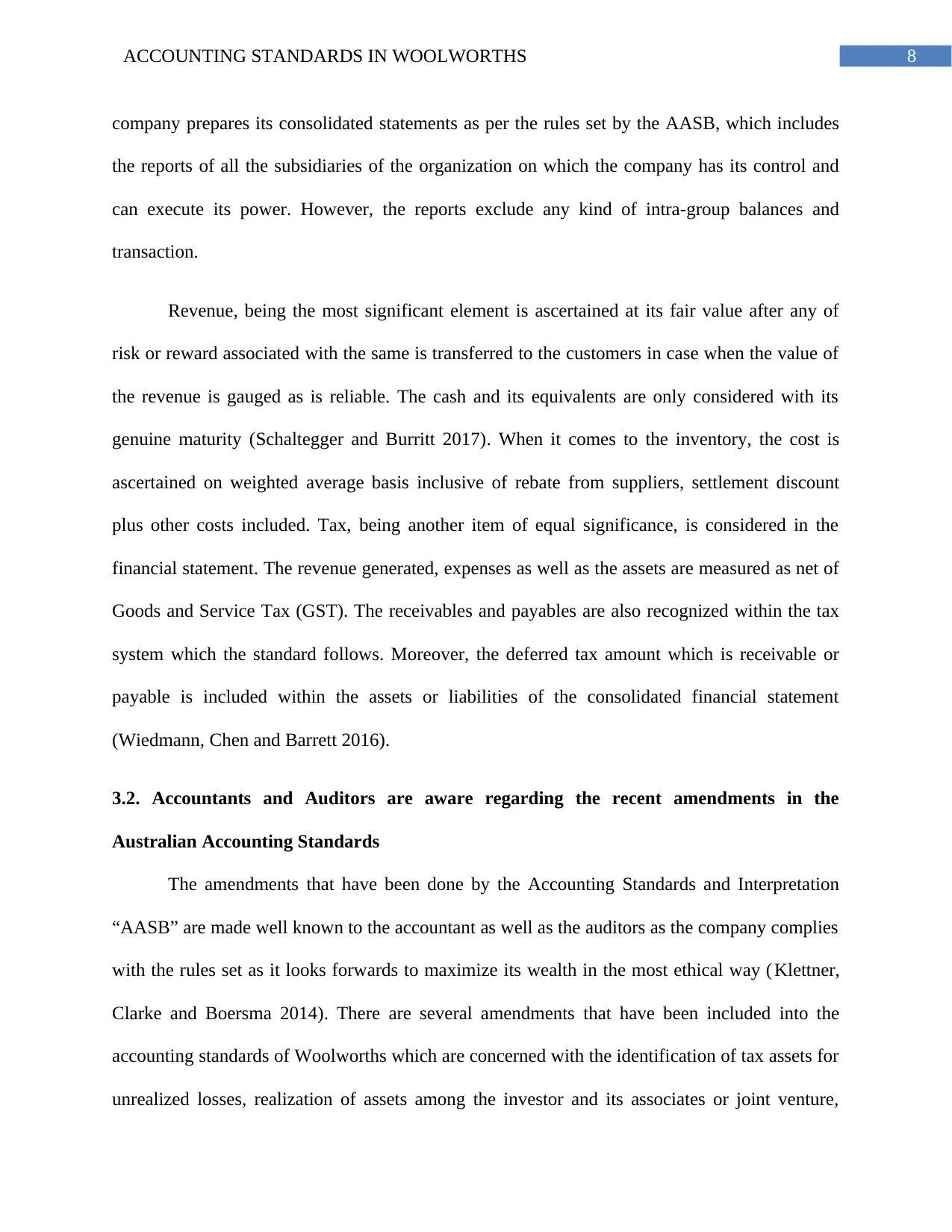
8ACCOUNTING STANDARDS IN WOOLWORTHS
company prepares its consolidated statements as per the rules set by the AASB, which includes
the reports of all the subsidiaries of the organization on which the company has its control and
can execute its power. However, the reports exclude any kind of intra-group balances and
transaction.
Revenue, being the most significant element is ascertained at its fair value after any of
risk or reward associated with the same is transferred to the customers in case when the value of
the revenue is gauged as is reliable. The cash and its equivalents are only considered with its
genuine maturity (Schaltegger and Burritt 2017). When it comes to the inventory, the cost is
ascertained on weighted average basis inclusive of rebate from suppliers, settlement discount
plus other costs included. Tax, being another item of equal significance, is considered in the
financial statement. The revenue generated, expenses as well as the assets are measured as net of
Goods and Service Tax (GST). The receivables and payables are also recognized within the tax
system which the standard follows. Moreover, the deferred tax amount which is receivable or
payable is included within the assets or liabilities of the consolidated financial statement
(Wiedmann, Chen and Barrett 2016).
3.2. Accountants and Auditors are aware regarding the recent amendments in the
Australian Accounting Standards
The amendments that have been done by the Accounting Standards and Interpretation
“AASB” are made well known to the accountant as well as the auditors as the company complies
with the rules set as it looks forwards to maximize its wealth in the most ethical way ( Klettner,
Clarke and Boersma 2014). There are several amendments that have been included into the
accounting standards of Woolworths which are concerned with the identification of tax assets for
unrealized losses, realization of assets among the investor and its associates or joint venture,
company prepares its consolidated statements as per the rules set by the AASB, which includes
the reports of all the subsidiaries of the organization on which the company has its control and
can execute its power. However, the reports exclude any kind of intra-group balances and
transaction.
Revenue, being the most significant element is ascertained at its fair value after any of
risk or reward associated with the same is transferred to the customers in case when the value of
the revenue is gauged as is reliable. The cash and its equivalents are only considered with its
genuine maturity (Schaltegger and Burritt 2017). When it comes to the inventory, the cost is
ascertained on weighted average basis inclusive of rebate from suppliers, settlement discount
plus other costs included. Tax, being another item of equal significance, is considered in the
financial statement. The revenue generated, expenses as well as the assets are measured as net of
Goods and Service Tax (GST). The receivables and payables are also recognized within the tax
system which the standard follows. Moreover, the deferred tax amount which is receivable or
payable is included within the assets or liabilities of the consolidated financial statement
(Wiedmann, Chen and Barrett 2016).
3.2. Accountants and Auditors are aware regarding the recent amendments in the
Australian Accounting Standards
The amendments that have been done by the Accounting Standards and Interpretation
“AASB” are made well known to the accountant as well as the auditors as the company complies
with the rules set as it looks forwards to maximize its wealth in the most ethical way ( Klettner,
Clarke and Boersma 2014). There are several amendments that have been included into the
accounting standards of Woolworths which are concerned with the identification of tax assets for
unrealized losses, realization of assets among the investor and its associates or joint venture,
⊘ This is a preview!⊘
Do you want full access?
Subscribe today to unlock all pages.

Trusted by 1+ million students worldwide
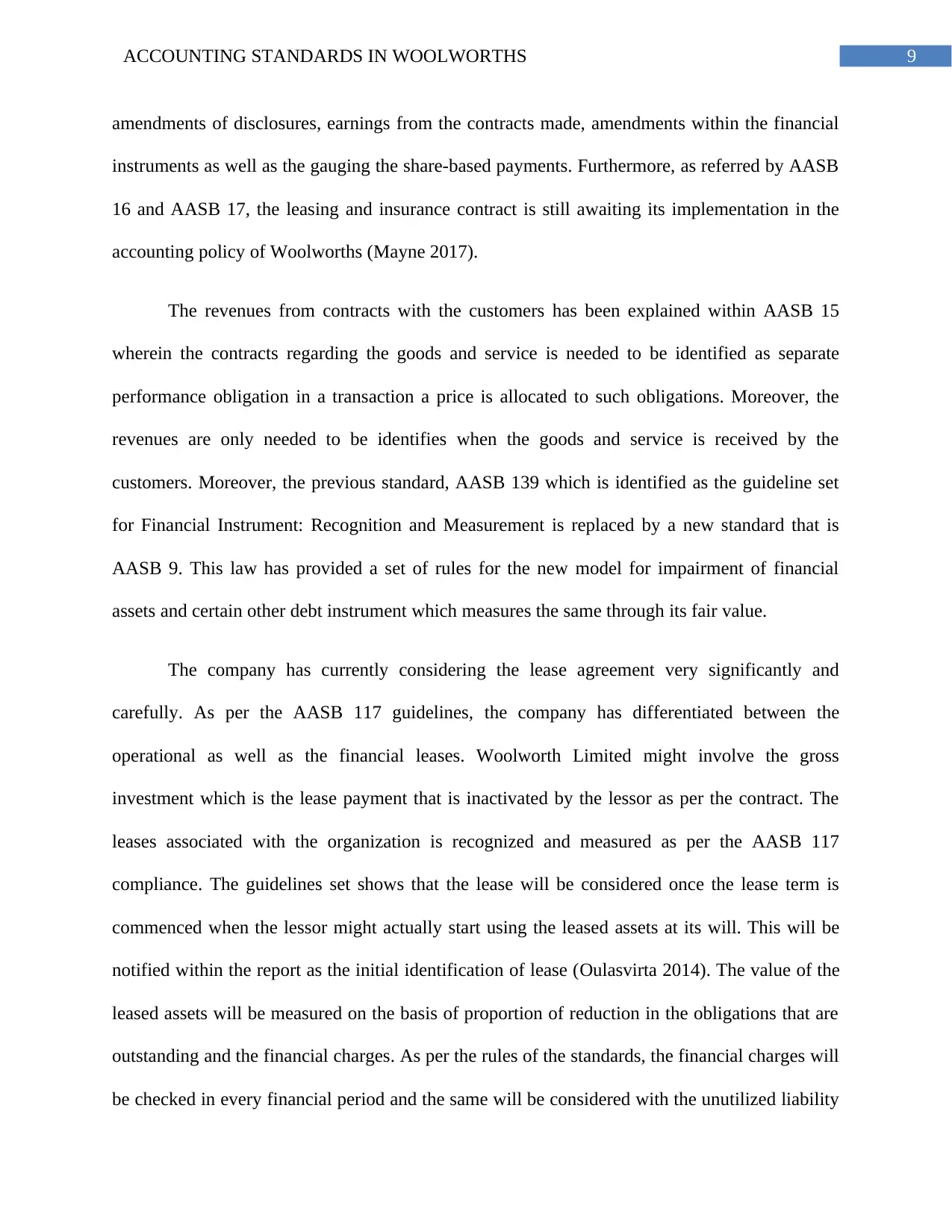
9ACCOUNTING STANDARDS IN WOOLWORTHS
amendments of disclosures, earnings from the contracts made, amendments within the financial
instruments as well as the gauging the share-based payments. Furthermore, as referred by AASB
16 and AASB 17, the leasing and insurance contract is still awaiting its implementation in the
accounting policy of Woolworths (Mayne 2017).
The revenues from contracts with the customers has been explained within AASB 15
wherein the contracts regarding the goods and service is needed to be identified as separate
performance obligation in a transaction a price is allocated to such obligations. Moreover, the
revenues are only needed to be identifies when the goods and service is received by the
customers. Moreover, the previous standard, AASB 139 which is identified as the guideline set
for Financial Instrument: Recognition and Measurement is replaced by a new standard that is
AASB 9. This law has provided a set of rules for the new model for impairment of financial
assets and certain other debt instrument which measures the same through its fair value.
The company has currently considering the lease agreement very significantly and
carefully. As per the AASB 117 guidelines, the company has differentiated between the
operational as well as the financial leases. Woolworth Limited might involve the gross
investment which is the lease payment that is inactivated by the lessor as per the contract. The
leases associated with the organization is recognized and measured as per the AASB 117
compliance. The guidelines set shows that the lease will be considered once the lease term is
commenced when the lessor might actually start using the leased assets at its will. This will be
notified within the report as the initial identification of lease (Oulasvirta 2014). The value of the
leased assets will be measured on the basis of proportion of reduction in the obligations that are
outstanding and the financial charges. As per the rules of the standards, the financial charges will
be checked in every financial period and the same will be considered with the unutilized liability
amendments of disclosures, earnings from the contracts made, amendments within the financial
instruments as well as the gauging the share-based payments. Furthermore, as referred by AASB
16 and AASB 17, the leasing and insurance contract is still awaiting its implementation in the
accounting policy of Woolworths (Mayne 2017).
The revenues from contracts with the customers has been explained within AASB 15
wherein the contracts regarding the goods and service is needed to be identified as separate
performance obligation in a transaction a price is allocated to such obligations. Moreover, the
revenues are only needed to be identifies when the goods and service is received by the
customers. Moreover, the previous standard, AASB 139 which is identified as the guideline set
for Financial Instrument: Recognition and Measurement is replaced by a new standard that is
AASB 9. This law has provided a set of rules for the new model for impairment of financial
assets and certain other debt instrument which measures the same through its fair value.
The company has currently considering the lease agreement very significantly and
carefully. As per the AASB 117 guidelines, the company has differentiated between the
operational as well as the financial leases. Woolworth Limited might involve the gross
investment which is the lease payment that is inactivated by the lessor as per the contract. The
leases associated with the organization is recognized and measured as per the AASB 117
compliance. The guidelines set shows that the lease will be considered once the lease term is
commenced when the lessor might actually start using the leased assets at its will. This will be
notified within the report as the initial identification of lease (Oulasvirta 2014). The value of the
leased assets will be measured on the basis of proportion of reduction in the obligations that are
outstanding and the financial charges. As per the rules of the standards, the financial charges will
be checked in every financial period and the same will be considered with the unutilized liability
Paraphrase This Document
Need a fresh take? Get an instant paraphrase of this document with our AI Paraphraser

10ACCOUNTING STANDARDS IN WOOLWORTHS
balance. The contingent rents will be charged as soon as they are incurred. A deposition expense
will be created as a measurement for the depreciation of the leased asset in each of the reporting
period (Simnett and Huggins 2015). Such amendments have been done by the Australian
Accounting Board and considered by Woolworths Limited so as to remain in line with new rules.
The accountant and auditors of the organization are well equipped with the new knowledge and
are practicing under the same to remain competitive in the market.
3.3. Harmonization between the AAS (Australian Accounting Standards) and the IAS
(International Accounting Standards)
Though there are certain differences between the Australian Accounting Standards and
the International Accounting Standards, but for most of the part the AASB incorporates the
guidelines similar to the IFRS which could be identified as the agent of harmonization between
the AAS and IAS. AASB and IAS had its differences in the notion of business combination but
the same has been absorbed by the Australian board as they amended which has been mentioned
in AASB 3 (Martinov-Bennie, Soh and Tweedie 2015). The difference has also been noticed in
the cash flow formation wherein the Australian board follows the direct method whereas the
International Accounting Standard follows both the direct as well as the indirect method. Here,
Woolworths also follows as per the method mentioned in the Australian board. The methods of
the cost flow computation do not affect the outcome significantly, hence both are accepted
globally. Moreover, as per the Australian board, the financial statement is needed to be
consolidated by the parent firm but the same is not necessary in case of International Accounting
Standard as it is prepared after all the subsidiary submit their reports. The reporting date as per
the Australian standards is that the subsidiary must have the same reporting date as the parent
company but in international standard, the subsidiary may happen to follow other reporting date
balance. The contingent rents will be charged as soon as they are incurred. A deposition expense
will be created as a measurement for the depreciation of the leased asset in each of the reporting
period (Simnett and Huggins 2015). Such amendments have been done by the Australian
Accounting Board and considered by Woolworths Limited so as to remain in line with new rules.
The accountant and auditors of the organization are well equipped with the new knowledge and
are practicing under the same to remain competitive in the market.
3.3. Harmonization between the AAS (Australian Accounting Standards) and the IAS
(International Accounting Standards)
Though there are certain differences between the Australian Accounting Standards and
the International Accounting Standards, but for most of the part the AASB incorporates the
guidelines similar to the IFRS which could be identified as the agent of harmonization between
the AAS and IAS. AASB and IAS had its differences in the notion of business combination but
the same has been absorbed by the Australian board as they amended which has been mentioned
in AASB 3 (Martinov-Bennie, Soh and Tweedie 2015). The difference has also been noticed in
the cash flow formation wherein the Australian board follows the direct method whereas the
International Accounting Standard follows both the direct as well as the indirect method. Here,
Woolworths also follows as per the method mentioned in the Australian board. The methods of
the cost flow computation do not affect the outcome significantly, hence both are accepted
globally. Moreover, as per the Australian board, the financial statement is needed to be
consolidated by the parent firm but the same is not necessary in case of International Accounting
Standard as it is prepared after all the subsidiary submit their reports. The reporting date as per
the Australian standards is that the subsidiary must have the same reporting date as the parent
company but in international standard, the subsidiary may happen to follow other reporting date
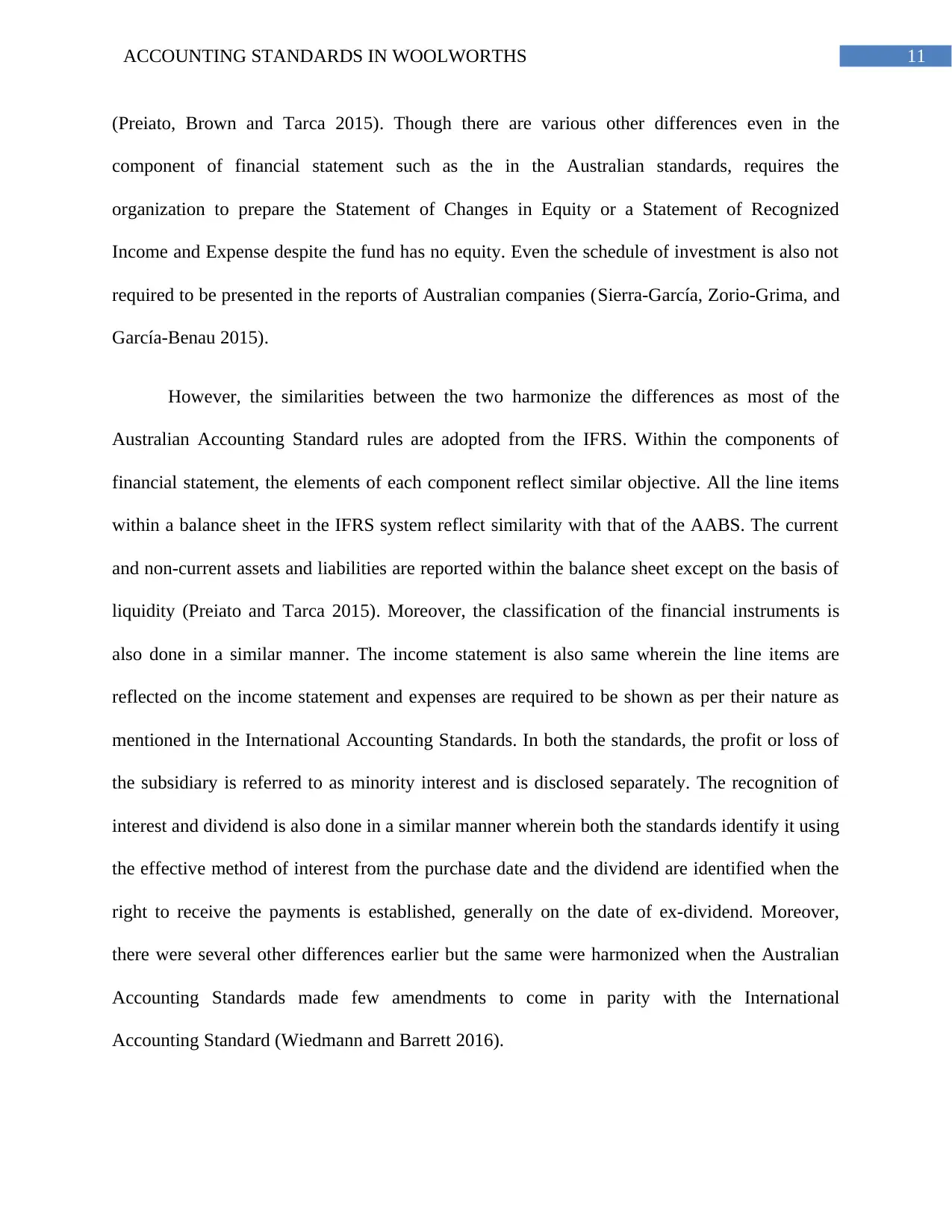
11ACCOUNTING STANDARDS IN WOOLWORTHS
(Preiato, Brown and Tarca 2015). Though there are various other differences even in the
component of financial statement such as the in the Australian standards, requires the
organization to prepare the Statement of Changes in Equity or a Statement of Recognized
Income and Expense despite the fund has no equity. Even the schedule of investment is also not
required to be presented in the reports of Australian companies (Sierra‐García, Zorio‐Grima, and
García‐Benau 2015).
However, the similarities between the two harmonize the differences as most of the
Australian Accounting Standard rules are adopted from the IFRS. Within the components of
financial statement, the elements of each component reflect similar objective. All the line items
within a balance sheet in the IFRS system reflect similarity with that of the AABS. The current
and non-current assets and liabilities are reported within the balance sheet except on the basis of
liquidity (Preiato and Tarca 2015). Moreover, the classification of the financial instruments is
also done in a similar manner. The income statement is also same wherein the line items are
reflected on the income statement and expenses are required to be shown as per their nature as
mentioned in the International Accounting Standards. In both the standards, the profit or loss of
the subsidiary is referred to as minority interest and is disclosed separately. The recognition of
interest and dividend is also done in a similar manner wherein both the standards identify it using
the effective method of interest from the purchase date and the dividend are identified when the
right to receive the payments is established, generally on the date of ex-dividend. Moreover,
there were several other differences earlier but the same were harmonized when the Australian
Accounting Standards made few amendments to come in parity with the International
Accounting Standard (Wiedmann and Barrett 2016).
(Preiato, Brown and Tarca 2015). Though there are various other differences even in the
component of financial statement such as the in the Australian standards, requires the
organization to prepare the Statement of Changes in Equity or a Statement of Recognized
Income and Expense despite the fund has no equity. Even the schedule of investment is also not
required to be presented in the reports of Australian companies (Sierra‐García, Zorio‐Grima, and
García‐Benau 2015).
However, the similarities between the two harmonize the differences as most of the
Australian Accounting Standard rules are adopted from the IFRS. Within the components of
financial statement, the elements of each component reflect similar objective. All the line items
within a balance sheet in the IFRS system reflect similarity with that of the AABS. The current
and non-current assets and liabilities are reported within the balance sheet except on the basis of
liquidity (Preiato and Tarca 2015). Moreover, the classification of the financial instruments is
also done in a similar manner. The income statement is also same wherein the line items are
reflected on the income statement and expenses are required to be shown as per their nature as
mentioned in the International Accounting Standards. In both the standards, the profit or loss of
the subsidiary is referred to as minority interest and is disclosed separately. The recognition of
interest and dividend is also done in a similar manner wherein both the standards identify it using
the effective method of interest from the purchase date and the dividend are identified when the
right to receive the payments is established, generally on the date of ex-dividend. Moreover,
there were several other differences earlier but the same were harmonized when the Australian
Accounting Standards made few amendments to come in parity with the International
Accounting Standard (Wiedmann and Barrett 2016).
⊘ This is a preview!⊘
Do you want full access?
Subscribe today to unlock all pages.

Trusted by 1+ million students worldwide
1 out of 25
Related Documents
Your All-in-One AI-Powered Toolkit for Academic Success.
+13062052269
info@desklib.com
Available 24*7 on WhatsApp / Email
![[object Object]](/_next/static/media/star-bottom.7253800d.svg)
Unlock your academic potential
Copyright © 2020–2025 A2Z Services. All Rights Reserved. Developed and managed by ZUCOL.





